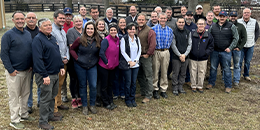Nuclear Scintigraphy is available at all three of our hospitals: Lexington, Saratoga & Wellington.
Nuclear scintigraphy, also known as bone scan, provides us with a screening tool to locate areas of increased metabolic activity in soft tissue or bone which may indicate a site of injury. This study allows us to image the entire horse in cases of subtle lameness or poor performance where an exact source of pain is difficult to identify. The horse is injected with a radioisotope that is absorbed in increased amounts in regions of the body undergoing bone turnover. The most commonly used tracer in equine scintigraphy is technetium-99 tagged to phosphorous which localizes to bone. Using a special gamma camera, any areas of increased uptake can be identified and pursued further with other diagnostic techniques.
Nuclear scintigraphy is particularly useful to image areas that are difficult to assess with other imaging modalities, such as the back and upper limb. The entire process takes only a few hours and the radioactive marker is 97% decayed in 30 hours, so horses are able to leave a day after the examination is completed.
Nuclear scintigraphy can detect problem areas that may not be readily apparent on radiographs (e.g., stress fractures, ligament injuries). It can also assist in diagnosis of horses with multiple sites of soreness. Scintigraphy does not replace other diagnostic tools such as radiographs or ultrasound but can provide additional valuable information as it looks at metabolic activity rather than anatomy.
As a worldwide leader in equine healthcare, we provide expertise for our patients in a caring, professional and ethical manner that creates value for the entire equine community.

2023 Lexington Shareholders

2023 Saratoga Shareholders

2023 Wellington Shareholders